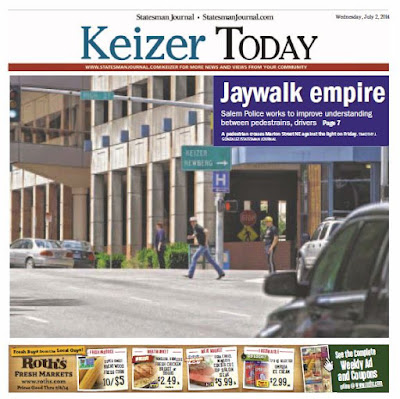 |
| Wholesome family activity? (yesterday) |
 |
| Lawless anarchy? (a year ago) |
Yesterday's piece in the South Salem supplement also shows one important set of reasons that walking isn't always an easy sell.
Just look at the barren walls and fences!
These aren't very attractive places. Our streetscapes are too often ugly, barren, or isolating. And if opaque fences seem to preserve privacy for homeowners, they also reduce eyes and ears on public space and create an incremental reduction in safety for people on foot.
The Just Walk project and the outcomes it envisions will not scale up if we don't also take more seriously land use, road design, aesthetics, and safety.
Remember Jeff Speck's 10 Steps of Walkability? Here are some of them on comfort and interest:
Time and time again, as people have documented Just Walk walks, we have seen the impoverishment of Salem's walking conditions. (Here's a neighborhood without sidewalks. And three very recent articles with nearly identical conclusions: "Memorable Streets Draw More Pedestrians," window coverage vs. blank walls in NYC, and one on Salt Lake City.)
And while the goal of getting people to walk is laudable, it's interesting how much the ordinary act of walking is made problematic - and something for which even "accountability" is necessary, rather than one of the foundational acts of a human person and something taken for granted:
Facebook comments get people inspired to join, and groups are listed on the website, justwalksalem.com. For the safety of the leaders, only their first names are listed, and one phone number serves the whole program. The policy of the program states the leader may participate only if there are at least two other walkers. For the safety of the walkers, the leader passes a background check. Legler and Hibbard agreed on many of the benefits of a walking group. Hibbard said that it’s safer to walk in numbers, participants feel more accountability when they’re part of a group, there is the social support, and people feel less self-conscious than when walking alone. Legler said, “It’s a very relaxed way to meet people. A conversation comes more naturally when you’re walking.”Our built environment too often doesn't promote safety. Our roadway designs, our typical auto speeds, and our development patterns directly contribute to a feeling of not being safe. Banding together for group walks addresses the feeling, but does not address the prior and directly contributing as-built conditions.
I counted more than 20 people out walking alone or in pairs during the event. “They all could be walking together,” said Hibbard. She stopped to talk to a few, telling them about the program and inviting them to join.
As for the people walking alone, maybe they are going somewhere - you know, using walking for transportation. The urge to channel walking to social, discretionary time is sometimes a little misguided. Most importantly, it misses that there are some people without a car, perhaps without money for a bus pass or for whom the hours of service and schedule are not useful, and who don't have time for a walking social hour. This is a way the program may be confined by assumptions about class and autoism. More individually, it also misses the ways walking can be meditative, a crucial ingredient in brainstorming and creativity, or a necessary break from sociality.
I understand that you have to meet people where they are, but I wonder if programming like Just Walk perpetuates the dysfunction rather than changing the culture.
 |
| Small projects, like painting bus shelters, are a start Puns via Cherriots |
 |
| But the real problems are structural and require larger change at the level of systems |




2 comments:
The Salem Weekly story touches on some of this -
http://www.willamettelive.com/2015/news/walking-program-welcomes-underserved-exercisers/
'Two of the groups are primarily Spanish-speaking; a Kaiser doctor leads the early Tuesday morning group; and Salem City Councilor Warren Bednarz leads one at Minto Brown Dog Park on Wednesdays.
Like many walk leaders, Campos knows her participants by name and says everyone encourages each other. “Because most of these people have very low paying jobs, they can’t afford a gym membership, or even have transportation to get to one,” she says. “And, not to mention, [they can’t] leave their children. So our walk is family-friendly; kids, moms and dads can attend.”'
Thanks for highlighting Just Walk Salem in your post. There are many improvements that could be made to the built environment of our city that would make the conditions here safer, more convenient, and more pleasant. Along with other biking and walking supporters, we are helping to organize a walk/ride rally to promote more pedestrian- and bike-friendly roadways as part of Salem Sunday Streets, and we encourage everyone to participate (more details are here: https://www.facebook.com/events/1597889473818646/).
There are so many reasons people walk: for social connection, for personal reflection, for health, for transportation, for stress relief, and out of necessity. For those who feel they would benefit from the companionship or sense of security a group walk provides, we aim to give them an opportunity to find and link up with others. We hope you will join us for a walk and conversation soon, if you are so inclined!
Post a Comment